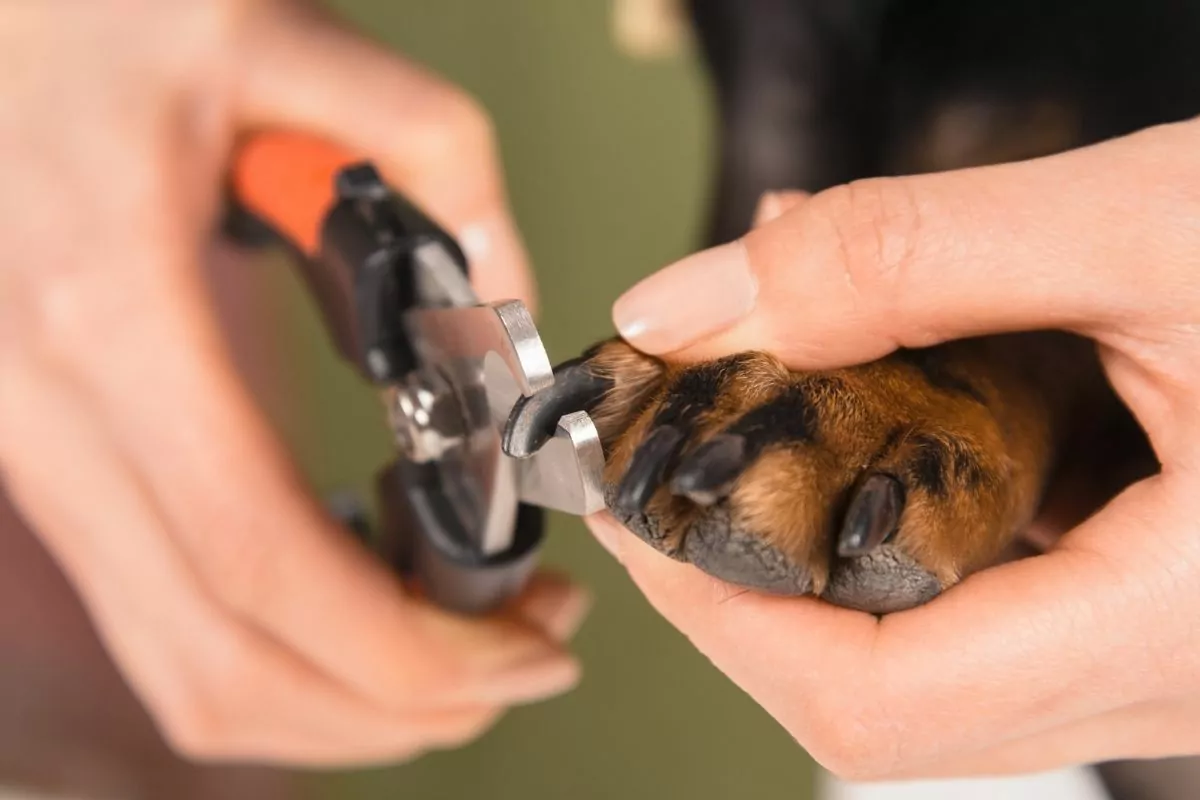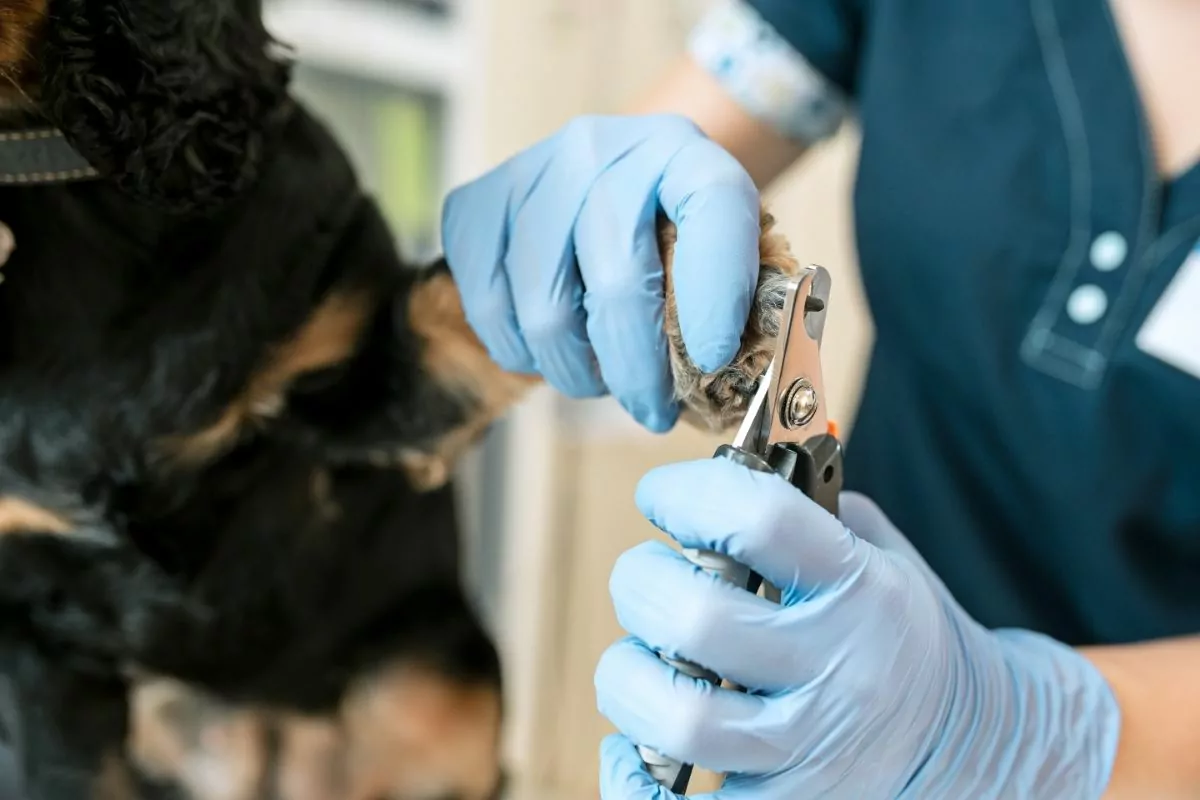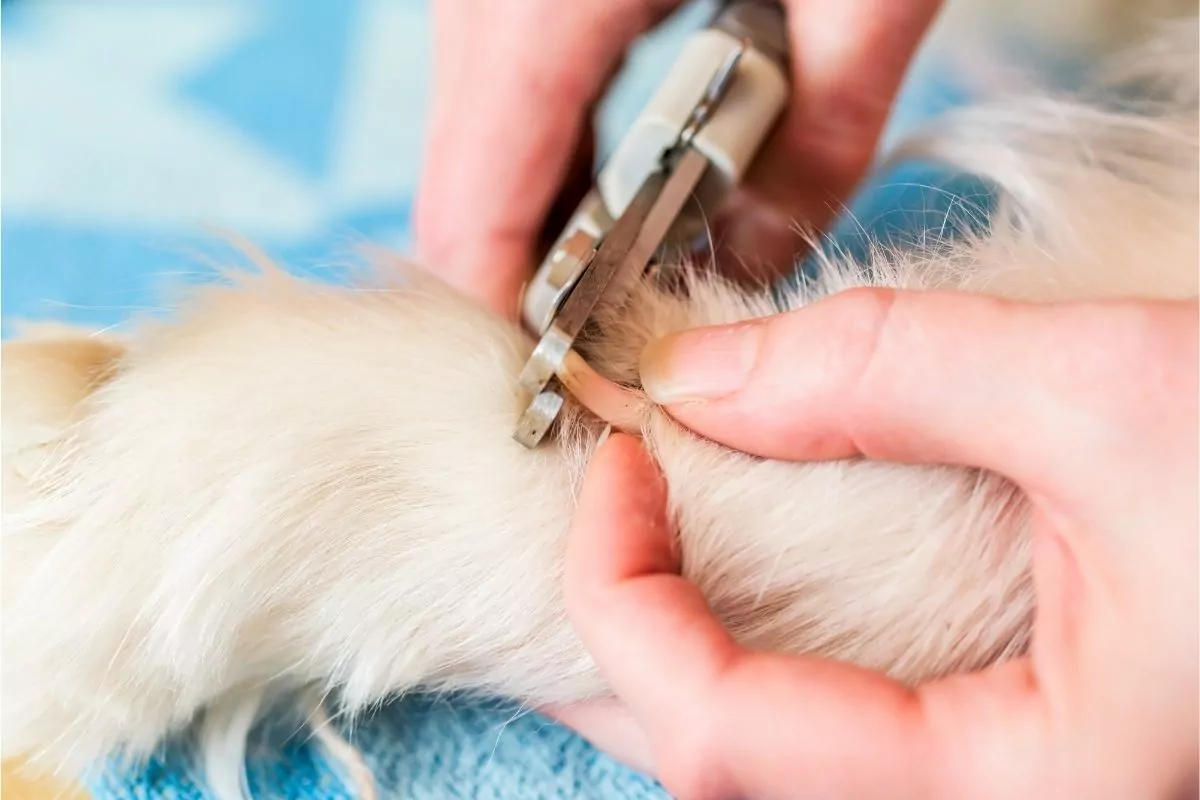What is a Dog Nail Bed Infection?
It is an infection of the soft tissue underneath the nail.
A dog nail bed infection may be secondary to underlying issues such as allergies, auto-immune disease, nutritional deficiency, neoplasia, diabetes mellitus, hyperadrenocorticism, hyperthyroidism, or pathogenic bacterial, fungal, or viral species entering through traumatic injuries to the paws or toes.
It is an uncomfortable and often quite painful condition that requires veterinary attention.

Symptoms of a Dog Nail Infection
How do you tell if your dog may have a nail infection? There are several things that you can look out for. The following are symptoms that are common in dogs with infected nail beds or infected toes:
- Swelling in the nail bed area or toes.
- Discharge from the area (i.e., blood, pus, serous).
- Discoloration of the nail or the toe.
- Fractured nail.
- Ingrown nail.
- Soft or brittle dog nails.
- Lameness, limping, non-weight bearing, or not favoring the affected toe.
- Irritation.
- Sensitive around the area.
- Frequent/constant licking or chewing the affected area.
- Fur loss around the affected area.
- Show dislike/aggression upon the palpation of the affected area.
- Lethargy.
- Reduced appetite.
- Vocalization when moving the affected area.
Diagnosing a Dog Nail Bed Infection
A diagnosis gets made by combining a relevant history obtained from the owner, a clinical presentation of the dog, and a physical examination focusing on the affected area performed by a veterinarian.
Diagnostic testing can further support the diagnosis, and they are essential when establishing a treatment plan. For example, cytology can identify the causal pathogenic organism and the immune cell responses present in a sample taken from the infected site.
Radiographic imaging can confirm any anatomical abnormalities of significance (e.g., deformity and musculoskeletal damage).
Blood testing may be necessary when the infection is secondary to an underlying medical condition, or the dog’s immune response must get analyzed.
How is a Dog Nail Bed Yeast Infection Treated?
Yeast infection occurs by a non-manageable overgrowth of fungus that naturally lives on dogs’ skin. Typical treatment of yeast infection in dogs is cleaning the affected area using an antiseptic solution and a course of antifungal and pain relief medications.
A commonly used antiseptic solution is Chlorhexidine Gluconate. It is effective against gram-positive bacteria, gram-negative bacteria, anaerobes, aerobes, and yeast organisms. However, its efficacy against viruses is still in question.
Antifungal medications come in several forms: oral, topical, shampoo, and spray. Please discuss with your veterinarian, and they can recommend the most suitable format for your dog.
What Do Healthy Dog Nails Look Like?
Dogs have nails similar to most other animal species that possess fingers. Their nails are more commonly known as claws. ‘Claws’ is preferred (accurate) terminology amongst scientific communities, yet either word can describe the same anatomy.
The nails are appendages that consist of keratin, a type of protein. Keratin also makes up fur and skin.
In dogs and most other claw-possessing animals, this keratin layer covers the distal part of each toe, protecting the soft tissue, the ungual process (part of the distal phalanx), and quick (a pink-colored tissue that consists of blood vessels and nerves) that lay underneath.
Dog nails can grow continuously and regenerate on their own if damaged in most cases. A healthy nail is solid/hard and smooth-surfaced with a pointy edge. The length of nails should not protrude over the footpads.
Some dogs have semi-transparent nails, while others have dark-colored nails. Some dogs possess a combination of both colors. The genetic component plays a large part in influencing the coloration (volume of pigmentation). Some may even change the color naturally throughout their lifetime.
Nails protect each digit’s tip and assist paws in performing maneuvers such as run, dig, and grip on things.
Recovery Rate and Prognosis of Dog Nail Infections
Nail infection in dogs generally takes several weeks to heal. It has a relatively good prognosis if the issue gets caught early on and any underlying problem gets successfully treated or managed.
Severe infection may take longer to resolve fully, or it may never get fully resolved but possibly be able to be managed.

Other Dog Nail Disorders to be Aware of
Nail infection is not the only condition that affects nails in dogs. Here is a list of some of the commonly seen nail issues:
- Ingrown nails.
- Onychomadesis (sloughing of the nail).
- Macronychia (unusually large nail).
- Onychitis (inflammation in the matrix of the claw).
- Paronychia (inflammation of the nail fold).
- Onychoschizia (splitting of the nail).
- Onychomalacia (softening of the claw).
- Trauma.
- Lupoid Onychodystrophy (abnormal nail formation).
Chihuahuas, Dachshunds, Dobermans, German Shepherd dogs, Gordon Setters, Rottweilers, and Shar-peis, are dog breeds predisposed to nail disorders.
Interesting Points to Consider Relating to Dog Nail Bed Infections
- The nail bed infection may not be apparent in its early stage, especially in dogs with long fur covering the infected area. Still, behavioral changes such as the dog chewing or attempting to trim its nail may give you a clue that there is a nail abnormality.
- Wet fur on paws can be another clue.
- Allergies and injuries are the most common cause of dog nail infections.
- Some allergy medications can alter a homeostatic microflora balance within the body and cause an excessive increase/over-population of those species.
- Excessive amounts of benign or helpful microflora such as bacteria species and yeasts can lead to medical issues such as inflammations and infections.
- Nail trauma can result from a human error during a nail trim. Some human errors occur when an inexperienced person uses an improper technique, and an inappropriate trimmer gets used.
- The owner should not perform nail trim of the infected toe or site. Instead, it should be done by a veterinary professional if the trim is beneficial during this time.
- A dog toenail infection should get treated by a veterinarian and should not be left untreated. Some people prefer to try dog nail bed home treatment first to see if the infection can get resolved, but this is a dangerous practice without clinically significant evidence to support it.
- Indoor dogs and dogs that do not walk on hard surfaces tend to have longer nails than outdoor dogs or dogs that walk on various terrains/surfaces as the nails of indoor dogs have fewer opportunities to trim their nails naturally).
- Dogs have the dewclaw on each front limb. Although the dewclaw is located slightly higher up within each paw, it is still a part of the paw.
- Dewclaws can get nail bed infections but are less common than other claws.
- Declawing (surgical removal of the claws) to prevent undesired behaviors or possible infections is not suitable as it is unethical and unnecessary.
- Even a simple broken toenail should not get treated lightly as the infection can develop with the smallest scaled entry point on the skin.
- Avoid taking your dog to the ocean, a dog park, and other public places that may be abundant in pathogenic microorganisms when you know the dog had foot/claw injuries recently.
- Dogs dig using their claws before and after toileting. Therefore, it may be an excellent idea to habituate cleaning their feet after each toileting. Once the dogs learn and get used to getting their feet cleaned each time, it may be more acceptable for you to touch the feet to perform other activities such as trimming their nails.
- Yeast infection is not contagious. Every dog has its population of yeast cells/microflora on its body. Therefore, it is generally not transmissible between dogs and not considered a zoonotic (contagious between the dog and human) condition. However, there can be an accidental opportunistic transmission between dogs on rare occasions.
- Some dogs are more predisposed to yeast infection. Australian terriers, Basset hounds, Chihuahuas, Cocker Spaniels, Dachshunds, Lhasa Apso, Maltese terriers, Poodles, Silky terriers, Shetland Sheepdogs, and West Highland White terriers are the example breeds for it.
- The nail-related issues can occur regardless of the dog’s age or gender.
- You should always ask to get your dog’s nails trimmed at every veterinary checkup. In this way, you can subtly remind your veterinarian to check the paws/claws. Although, if any abnormality gets detected, they may hold off the nail trim until it gets resolved.

The Final Claw
The nail-related issues are underrated conditions and “less-spoken” topics in dogs. Yet, their clinical significance is undeniable as they can cause discomfort, pain, and noticeable damage to the health of the affected dogs.
Your dog’s nail infection may be bacterial, viral, or fungal and can be resulted from injuries or underlying medical issues. Signs of the infection may be subtle or obvious, but you would likely notice the abnormalities if you regularly check your dog’s feet.
The diagnosis is made based on the history, clinical presentation, and possible diagnostic testing. The prognosis is good with an early diagnosis and a well-established treatment plan. The affected dogs would likely recover entirely if the condition, including any underlying issue, is treatable or manageable.
Although the prognosis is good, it is good to minimize developing this condition by implementing preventive measures. Such as good hygiene practices, a good diet to promote and maintain a strong immune system, regular body checks, regular nail trim, and regular veterinary health checks.
